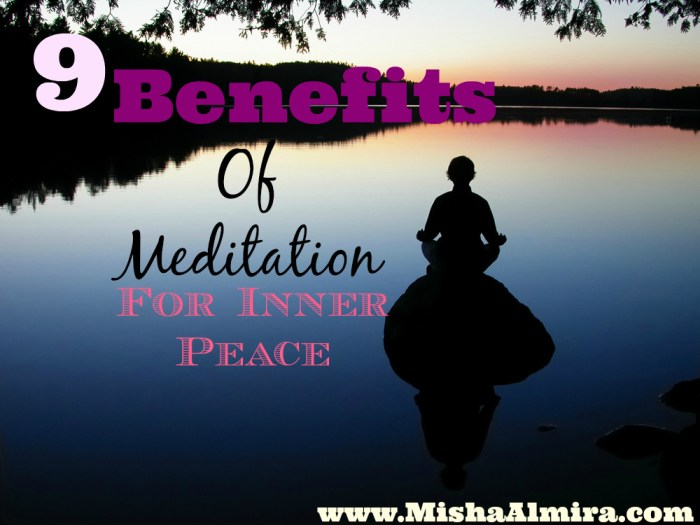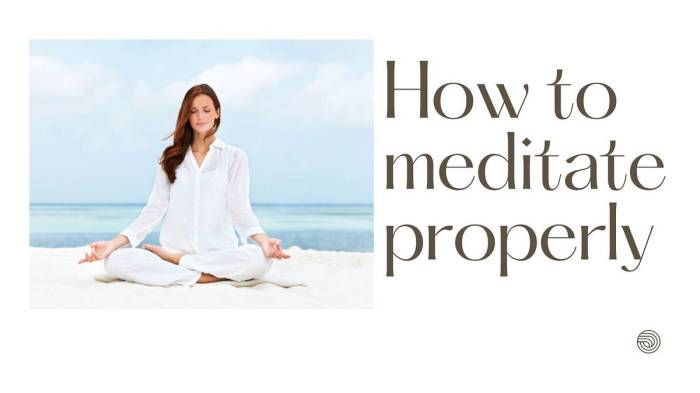How to Meditate for Developing Inner Peace sets the stage for a transformative journey towards serenity and self-discovery. Dive into the essence of meditation and unlock the path to inner peace.
Embark on a quest to explore different meditation techniques, create a harmonious meditation environment, overcome challenges, and seamlessly integrate meditation into your daily routine.
Introduction to Meditation for Inner Peace

Meditation is a practice that involves focusing the mind and eliminating distractions to achieve a state of deep peace and relaxation. It is a technique that has been used for centuries to promote mental clarity, emotional stability, and spiritual growth.
Importance of Meditation for Developing Inner Peace
Meditation plays a crucial role in developing inner peace by allowing individuals to quiet the mind, reduce stress, and cultivate a sense of inner harmony. Through regular practice, meditation helps individuals connect with their inner selves, leading to a greater sense of self-awareness and emotional balance.
As we navigate the complexities of emotional intelligence, one powerful tool that can be utilized is meditation. By practicing How to Meditate to Boost Your Emotional Intelligence , individuals can enhance their self-awareness and empathy. This practice enables a deeper understanding of emotions, leading to improved interpersonal relationships and decision-making skills.
- Reduces Stress: Meditation helps in calming the mind and reducing the levels of stress hormones in the body, promoting a sense of relaxation and tranquility.
- Enhances Emotional Well-being: By promoting mindfulness and self-reflection, meditation allows individuals to better understand and manage their emotions, leading to a more positive outlook on life.
- Improves Concentration: Regular meditation practice can enhance focus and concentration, leading to improved cognitive function and mental clarity.
Benefits of Incorporating Meditation into Daily Life
By incorporating meditation into daily life, individuals can experience a wide range of benefits that positively impact their overall well-being and quality of life.
- Increased Self-awareness: Meditation helps individuals become more attuned to their thoughts, emotions, and inner experiences, leading to a deeper understanding of themselves.
- Better Stress Management: Regular meditation practice equips individuals with effective tools to cope with stress and challenges, promoting resilience and emotional well-being.
- Enhanced Mindfulness: By cultivating mindfulness through meditation, individuals can live more fully in the present moment, reducing anxiety about the past or future.
Different Meditation Techniques

When it comes to developing inner peace through meditation, there are various techniques that can be explored. Each technique offers a unique approach to calming the mind and cultivating a sense of tranquility.
Mindfulness Meditation
Mindfulness meditation involves focusing on the present moment without judgment. It encourages practitioners to observe their thoughts, sensations, and emotions as they arise, allowing them to develop a sense of awareness and acceptance.
- Find a quiet place to sit comfortably with your eyes closed.
- Focus on your breath, observing the sensation of each inhale and exhale.
- When your mind wanders, gently bring your attention back to your breath without judgment.
- Continue this practice for a few minutes to start and gradually increase the duration as you become more comfortable.
Loving-Kindness Meditation
Loving-kindness meditation, also known as Metta meditation, involves cultivating feelings of love, compassion, and goodwill towards oneself and others. This practice aims to foster a sense of connection and kindness towards all beings.
Emotional trauma can have a lasting impact on mental well-being. To address and release these emotional wounds, individuals can turn to meditation. Through How to Meditate for Releasing Emotional Trauma , individuals can cultivate a sense of peace and healing. This practice allows for the processing and letting go of past traumas, promoting emotional resilience and growth.
- Sit in a comfortable position and close your eyes.
- Begin by focusing on sending love and kindness to yourself by repeating phrases like “May I be happy, may I be healthy, may I be safe, may I live with ease.”
- Extend these wishes to loved ones, acquaintances, and even to those you may have difficulties with.
- Practice this meditation regularly to cultivate feelings of love and compassion.
Creating a Peaceful Meditation Environment: How To Meditate For Developing Inner Peace
![]()
Creating a tranquil and harmonious space for meditation is crucial to enhance the overall experience and help in achieving inner peace. The environment plays a significant role in calming the mind and eliminating distractions, allowing you to focus inwardly and connect with your spiritual self.
Amidst the pursuit of happiness, meditation can serve as a valuable tool. By following How to Meditate for Happiness: 7 Simple Steps , individuals can cultivate a sense of inner joy and contentment. This practice promotes mindfulness and gratitude, leading to a more positive outlook on life and overall well-being.
The Role of Setting Up a Peaceful Space
- Choose a quiet spot in your home where you won’t be disturbed during your meditation practice.
- Clear the area of any clutter or distractions to create a sense of openness and tranquility.
- Consider using natural elements like plants or crystals to bring a sense of grounding and connection to nature.
- Use comfortable cushions or a meditation mat to sit on, ensuring proper posture and relaxation during your practice.
Enhancing the Environment with Lighting, Sound, and Decor
- Soft, dim lighting such as candles or salt lamps can create a calming atmosphere and help you relax.
- Play gentle music or nature sounds in the background to promote relaxation and focus during meditation.
- Consider incorporating spiritual or meaningful decor elements like statues, symbols, or artwork to inspire and deepen your practice.
- Personalize your meditation space with items that hold special significance to you, creating a sacred and sacred space for your practice.
Overcoming Challenges in Meditation

When engaging in meditation practice, it is common to face various challenges that can hinder your ability to find inner peace. These challenges often manifest as distractions, restlessness, wandering thoughts, and impatience. It is essential to address these obstacles effectively to maintain focus and experience the full benefits of meditation.
Strategies to Overcome Distractions
Distractions can arise from external noises, discomfort in the body, or even internal thoughts. To overcome distractions during meditation, consider the following strategies:
- Acknowledge the distraction without judgment and gently guide your focus back to your breath or mantra.
- Practice mindfulness by observing the distraction without getting attached to it, allowing it to pass without disrupting your meditation.
- Create a designated meditation space that is free from distractions and conducive to a peaceful practice.
Dealing with Restlessness and Wandering Thoughts
Restlessness and wandering thoughts are common challenges that many meditators encounter. To address these issues, try the following techniques:
- Focus on your breath to anchor your mind and bring your attention back to the present moment whenever restlessness arises.
- Use a guided meditation or visualization to help maintain focus and prevent your thoughts from wandering.
- Practice self-compassion and patience, understanding that it is natural for the mind to wander and gently redirecting your focus without judgment.
Cultivating Patience in Meditation
Impatience can often arise during meditation, especially when progress feels slow or when the mind is particularly restless. To cultivate patience in your practice, consider the following tips:
- Set realistic expectations for your meditation practice and understand that consistency and patience are key to reaping the benefits.
- Practice loving-kindness and compassion towards yourself, acknowledging that each moment of practice is valuable, regardless of perceived progress.
- Engage in grounding activities outside of meditation to help cultivate patience and presence in your everyday life, which can carry over into your meditation practice.
Incorporating Meditation into Daily Routine

Meditation is a powerful practice that can bring peace and clarity to your daily life. To fully experience the benefits of meditation, it is essential to integrate it into your daily routine in a consistent and committed manner.
Establishing a Consistent Meditation Practice, How to Meditate for Developing Inner Peace
- Choose a specific time each day for meditation, whether it’s in the morning to start your day with a clear mind or in the evening to unwind and relax.
- Create a dedicated meditation space in your home where you can practice without distractions. This could be a corner of a room with cushions or a comfortable chair.
- Start with short meditation sessions, gradually increasing the duration as you become more comfortable with the practice.
- Set realistic goals for your meditation practice and track your progress to stay motivated.
- Use reminders or alarms to help you remember to meditate each day until it becomes a natural part of your routine.
Ideal Times for Meditation and Making it a Habit
- Morning meditation can set a positive tone for the rest of the day, helping you approach challenges with a calm and focused mindset.
- Evening meditation can help you unwind and release the stress of the day, promoting better sleep and relaxation.
- Choose a time that works best for you and stick to it consistently to establish a meditation habit.
- Consider incorporating meditation into existing daily routines, such as after brushing your teeth or before bedtime, to make it easier to remember and practice.
- Experiment with different times of the day to find what works best for you and your schedule.
Embrace the power of meditation as a tool for cultivating inner peace and balance in your life. Let the practice of meditation be your guiding light towards a calmer mind and a more peaceful existence.